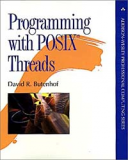Книга: Programming with POSIX® Threads
1.3.1 ... because UNIX is asynchronous
1.3.1 ... because UNIX is asynchronous
In any UNIX system, processes execute asynchronously with respect to each other, even when there is only a single processor. Yes, until recently it was difficult to write individual programs for UNIX that behaved asynchronously—but UNIX has always made it fairly easy for you to behave asynchronously. When you type a command to a shell, you are really starting an independent program—if you run the program in the background, it runs asynchronously with the shell. When you pipe the output of one command to another you are starting several independent programs, which synchronize between themselves using the pipe.
I Time is a synchronization mechanism.
In many cases you provide synchronization between a series of processes yourself, maybe without even thinking about it. For example, you run the compiler after you've finished editing the source files. It wouldn't occur to you to compile them first, or even at the same time. That's elementary real-life synchronization.
I UNIX pipes and files can be synchronization mechanisms.
In other cases you may use more complicated software synchronization mechanisms. When you type "ls|more" to a shell to pass the output of the ls command into the more command, you're describing synchronization by specifying a data dependency. The shell starts both commands right away, but the more command can't generate any output until it receives input from ls through the pipe. Both commands proceed concurrently (or even in parallel on a multiprocessor) with ls supplying data and more processing that data, independently of each other. If the pipe buffer is big enough, ls could complete before more ever started; but more can't ever get ahead of ls.
Some UNIX commands perform synchronization internally. For example, the command "cc -o thread thread.c" might involve a number of separate processes. The cc command might be a "front end" to the C language environment, which runs a filter to expand preprocessor commands (like #include and #if), a compiler to translate the program into an intermediate form, an optimizer to reorder the translation, an assembler to translate the intermediate form into object language, and a loader to translate that into an executable binary file. As with ls |more, all these programs may be running at the same time, with synchronization provided by pipes, or by access to temporary files.
UNIX processes can operate asynchronously because each process includes all the information needed to execute code. The operating system can save the state of one process and switch to another without affecting the operation of either. Any general-purpose asynchronous "entity" needs enough state to enable the operating system to switch between them arbitrarily. But a UNIX process includes additional state that is not directly related to "execution context," such as an address space and file descriptors.
A thread is the part of a process that's necessary to execute code. On most computers that means each thread has a pointer to the thread's current instruction (often called a "PC" or "program counter"), a pointer to the top of the thread's stack (SP), general registers, and floating-point or address registers if they are kept separate. A thread may have other things, such as processor status and coprocessor control registers. A thread does not include most of the rest of the state associated with a process; for example, threads do not have their own file descriptors or address space. All threads within a process share all of the files and memory, including the program text and data segments.
I Threads are "simpler" than processes.
You can think of a thread as a sort of "stripped down" process, lean and mean and ready to go. The system can switch between two threads within a process much faster than it can switch between processes. A large part of this advantage comes from the fact that threads within a process share the address space—code, data, stack, everything.
When a processor switches between two processes, all of the hardware state for that process becomes invalid. Some may need to be changed as part of the context switch procedure—data cache and virtual memory translation entries may be flushed, for example. Even when they do not need to be flushed immediately, however, the data is not useful to the new process. Each process has a separate virtual memory address space, but threads running within the same process share the virtual address space and all other process data.
Threads can make high-bandwidth communication easier between independent parts of your program. You don't have to worry about message passing mechanisms like pipes or about keeping shared memory region address references consistent between several different address spaces. Synchronization is faster, and programming is much more natural. If you create or open a file, all threads can use it. If you allocate a dynamic data structure with malloc, you can pass the address to other threads and they can reference it. Threads make it easy to take advantage of concurrency.
- 1.3 Asynchronous programming is intuitive ...
- Глава 1 UNIX для начинающих
- ЧАСТЬ 1 ВВЕДЕНИЕ В IPC UNIX
- Using the Common UNIX Printing System GUI
- UNIX Security Considerations
- Как не следует делать это - C-Unix пример
- ГЛАВА 1 Обзор средств взаимодействия процессов Unix
- 2.2. ASYNCHRONOUS TRANSFER MODE NETWORKS
- 2.2.1. What Is Asynchronous Transfer Mode?
- 4.5.3. Synchronous versus Asynchronous Systems
- 8.1.4. The Mach BSD UNIX Server
- 8.5. UNIX EMULATION IN MACH




